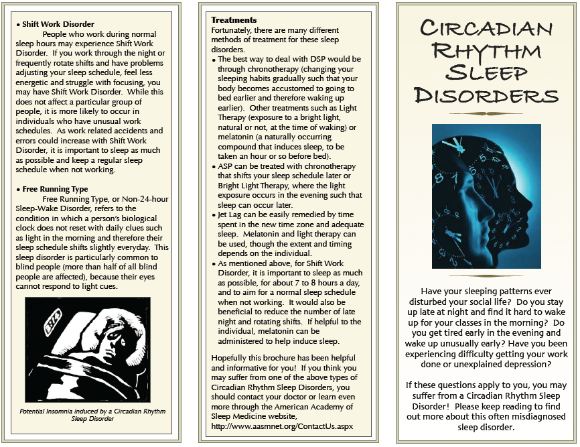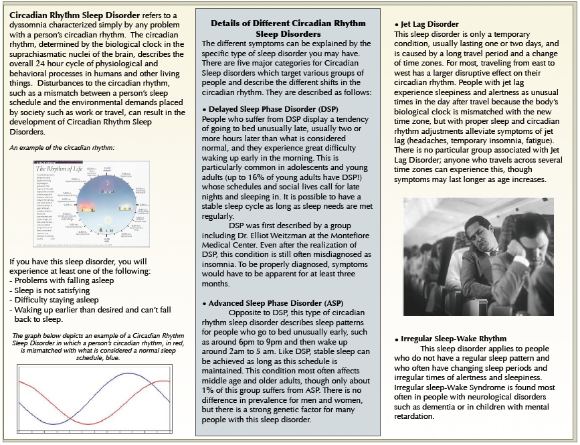
| Connect & Subscribe |
Circadian Rhythm Sleep Disorders Brochure
An Outreach Project by Christina Ospina | Return To Outreach Projects 2010
The following is a student-made brochure created for Stanford Sleep and Dreams. If it is difficult to read using the images, you may view the full text here.
Also feel free to download this brochure for distributional or general information purposes. Please refer to our privacy policy for our relevant disclaimers.


Full Text
Have your sleeping patterns ever disturbed your social life? Do you stay up late at night and find it hard to wake up for your classes in the morning? Do you get tired early in the evening and wake up unusually early? Have you been experiencing difficulty getting your work done or unexplained depression?
If these questions apply to you, you may suffer from a Circadian Rhythm Sleep Disorder! Please keep reading to find out more about this often misdiagnosed sleep disorder.
Circadian Rhythm Sleep Disorder refers to a dyssomnia characterized simply by any problem with a person's circadian rhythm. The circadian rhythm, determined by the biological clock in the superchiasmatic nuclei of the brain, describes the overall 24 hour cycle of physiological and behavioral processes in humans and other living things. Disturbances to the circadian rhythm, such as a mismatch between a person's sleep schedule and the environmental demands placed by society such as work or travel, can result in the development of Circadian Rhythm Sleep Disorders.
Details of Different Circadian Rhythm Sleep Disorders
The different symptoms can be explained by the specific type of sleep disorder you may have. There are five major categories for Circadian Sleep disorders which target various groups of people and describe the different shifts in the circadian rhythm. They are described as follows:
Delayed Sleep Phase Disorder (DSP)
People who suffer from DSP display a tendency of going to bed unusually late, usually two or more hours later than what is considered normal, and they experience great difficulty waking up early in the morning. This is particularly common in adolescents and young adults (up to 16% of young adults have DSP!) whose schedules and social lives call for late nights and sleeping in. It is possible to have a stable sleep cycle as long as sleep needs are met regularly.
DSP was first described by a group including Dr. Elliot Weitzman at the Montefiore Medical Center. Even after the realization of DSP, this condition is still often misdiagnosed as insomnia. To be properly diagnosed, symptoms would have to be apparent for at least three months.
Advanced Sleep Phase Disorder (ASP)
Opposite to DSP, this type of circadian rhythm sleep disorder describes sleep patterns for people who go to bed unusually early, such as around 6pm to 9pm and then wake up around 2am to 5 am. Like DSP, stable sleep can be achieved as long as this schedule is maintained. This condition most often affects middle age and older adults, though only about 1% of this group suffers from ASP. There is no difference in prevalence for men and women, but there is a strong genetic factor for many people with this sleep disorder.
Shift Work Disorder
People who work during normal sleep hours may experience Shift Work Disorder. If you work through the night or frequently rotate shifts and have problems adjusting your sleep schedule, feel less energetic and struggle with focusing, you may have Shift Work Disorder. While this does not affect a particular group of people, it is more likely to occur in individuals who have unusual work schedules. As work related accidents and errors could increase with Shift Work Disorder, it is important to sleep as much as possible and keep a regular sleep schedule when not working.
Free Running Type
Free Running Type, or Non-24-hour Sleep-Wake Disorder, refers to the condition in which a person's biological clock does not reset with daily clues such as light in the morning and therefore their sleep schedule shifts slightly everyday. This sleep disorder is particularly common to blind people (more than half of all blind people are affected), because their eyes cannot respond to light cues.
Jet Lag Disorder
This sleep disorder is only a temporary condition, usually lasting one or two days, and is caused by a long travel period and a change of time zones. For most, traveling from east to west has a larger disruptive effect on their circadian rhythm. People with jet lag experience sleepiness and alertness as unusual times in the day after travel because the body's biological clock is mismatched with the new time zone, but with proper sleep and circadian rhythm adjustments alleviate symptoms of jet lag (headaches, temporary insomnia, fatigue). There is no particular group associated with Jet Lag Disorder; anyone who travels across several time zones can experience this, though symptoms may last longer as age increases.
Irregular Sleep-Wake Rhythm
This sleep disorder applies to people who do not have a regular sleep pattern and who often have changing sleep periods and irregular times of alertness and sleepiness. Irregular sleep-Wake Syndrome is found most often in people with neurological disorders such as dementia or in children with mental retardation.
Treatments
Fortunately, there are many different methods of treatment for these sleep disorders.
- The best way to deal with DSP would be through chronotherapy (changing your sleeping habits gradually such that your body becomes accustomed to going to bed earlier and therefore waking up earlier). Other treatments such as Light Therapy (exposure to a bright light, natural or not, at the time of waking) or melatonin (a naturally occurring compound that induces sleep, to be taken an hour or so before bed).
- ASP can be treated with chronotherapy that shifts your sleep schedule later or Bright Light Therapy, where the light exposure occurs in the evening such that sleep can occur later.
- Jet Lag can be easily remedied by time spent in the new time zone and adequate sleep. Melatonin and light therapy can be used, though the extent and timing depends on the individual.
- As mentioned above, for Shift Work Disorder, it is important to sleep as much as possible, for about 7 to 8 hours a day, and to aim for a normal sleep schedule when not working. It would also be beneficial to reduce the number of late night and rotating shifts. If helpful to the individual, melatonin can be administered to help induce sleep.
Hopefully this brochure has been helpful and informative for you! If you think you may suffer from one of the above types of Circadian Rhythm Sleep Disorders, you should contact your doctor or learn even more through the American Academy of Sleep Medicine website, http://www.aasmnet.org/ContactUs.aspx.
Return To All Outreach Projects 2010
Learn more about Delayed Sleep Phase Disorder
Learn more about sleep than 99% of the world with our Sleep Essentials Mini-Guide
About This Site
Welcome! This site is continuously being created by students of Dr. William C. Dement's Sleep And Dreams course at Stanford University.
We made this site as a call to action for people all over the world to live healthier, happier, safer, and more productive lives by learning about their own sleep. We have faith that reading the information provided on this site will motivate you to be smart about your sleep deprivation and strategic about your alertness in order to live life to your fullest, most energetic potential.
In fact, we challenge you to do so! What do you say, are you up for the challenge?
Interviews With Sleep Specialists: Insights Into the Worlds of Sleep Medicine & Sleep Business
America's Most Dangerous Disorder: What Is Sleep Apnea Doing To Your Sleep?
Sleep Debt: How Much More Will You Achieve When You Reduce Yours?
The Stages Of Sleep: The Journey Through The Night
Delayed Sleep Phase: You Want To Sleep But You're Not Tired Yet
Paralyzed at Night: Is Sleep Paralysis Normal?
Sleep In Words: Smart, Strange, and Funny Quotes About Sleep
Sleep Disorders In Children: What's Keeping Your Child From A Full Night's Rest?
Attacks of Pavor Nocturnus (a.k.a. Sleep Terrors, Night Terrors, or Incubus Attacks)
The Stanford Sleep Book
Dr. Dement's pioneering textbook has been the core text for Sleep and Dreams since 1980, but it has just recently been made available to the wider public for the first time.
In it you'll find a more detailed account of the most important things you need to know about sleep, alertness, dreams, and sleep disorders. Studies, statistics, plus plenty of Dr. Dement's classic anecdotes painting the history of sleep medicine.
Preface | Intro | Contents | Get A Copy
More Sleep Resources
The Zeo
A revolution in personal sleep tracking, the Zeo is a wireless headband that transmits your brainwaves in realtime to a dock (pictured here) or your smartphone. The result? You can wake up and see exactly what stages of sleep you were in during the night! Unprecedented personalized sleep knowledge.
Sleep Paralysis: A Dreamer's Guide
Ever woken up paralyzed? A surprising number of us have, believe it or not. But few know the actual causes of this phenomenon, and fewer still how to exert control over it. Dream researcher and sleep paralysis expert Ryan Hurd shares breakthrough insights into how to do just that.
Important Disclaimer
Please Note:
The information found on this page and throughout this site is intended for general information purposes only. While it may prove useful and empowering, it is NOT intended as a substitute for the expertise and judgments of healthcare practitioners.
For more info, see our
Terms of Use.









